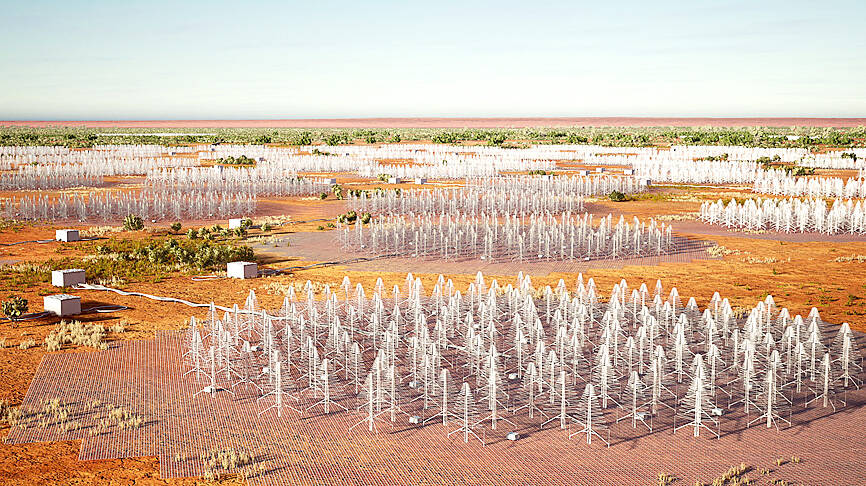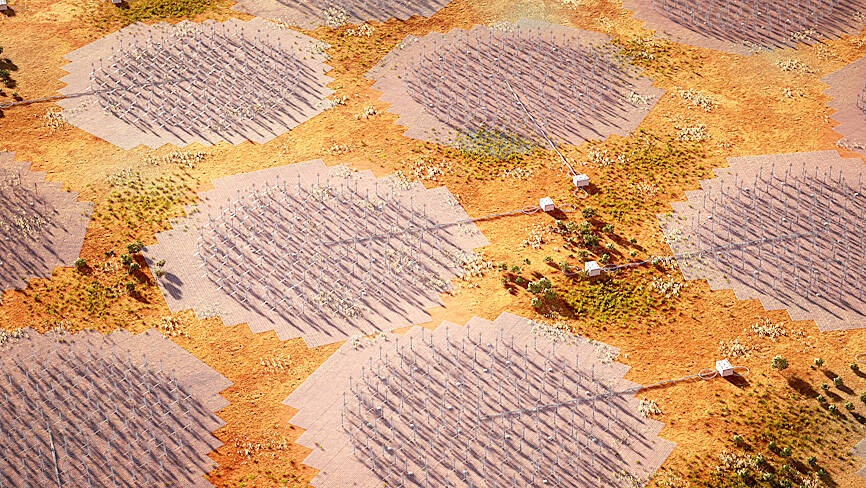Australia yesterday started building a vast network of antennas in the outback, its section of what planners say would eventually become one of the most powerful radio telescopes in the world.
When complete, the antennas in Australia and a network of dishes in South Africa would form the Square Kilometre Array (SKA), a massive instrument that would aim to untangle mysteries about the creation of stars, galaxies and extraterrestrial life.
The telescope was first conceived in the early 1990s, but the project was plagued by delays, funding issues and diplomatic jockeying.

Photo: AFP / Australian Department of Industry, Science and Resources
SKA Observatory director-general Philip Diamond described the beginning of its construction as “momentous.”
The telescope “will be one of humanity’s biggest-ever scientific endeavors,” he said.
Its name is based on the planners’ original aim, a telescope that could observe a 1km2 surface, but the current South African and Australian sections would have a combined collecting area of just less than half that, the observatory said.

Photo: AFP / Australian Department of Industry, Science and Resources
Both countries have huge expanses of land in remote areas with little radio disturbance — ideal for such telescopes.
More than 130,000 Christmas tree-shaped antennas are planned in Western Australia, to be built on the traditional lands of the Wajarri people.
They have dubbed the site “Inyarrimanha Ilgari Bundara,” or “sharing sky and stars.”
“We honor their willingness to share their skies and stars with us as we seek to find answers to some of the most fundamental science questions we face,” Diamond said.
The South African site is to feature nearly 200 dishes in the remote Karoo region, the organization said.
Comparison between radio telescopes is difficult as they operate in different frequencies, SKA’s planners said.
However, the two sites would give SKA higher sensitivity over single-dish radio telescopes because its arrays are spread out, forming a much bigger “virtual dish,” they said.
The project would help in “charting the birth and death of galaxies, searching for new types of gravitational waves and expanding the boundaries of what we know about the universe,” telescope director Sarah Pearce said.
Danny Price, a senior research fellow at the Curtin Institute of Radio Astronomy, said the telescope would be extremely powerful.
“To put the sensitivity of the SKA into perspective, the SKA could detect a mobile phone in the pocket of an astronaut on Mars, 225 million kilometers away,” he said.
The SKA Observatory, headquartered at the Jodrell Bank Observatory in Cheshire, England, has said the telescope should start making scientific observations by the late 2020s.
The organization has 14 members: Australia, South Africa, Canada, China, France, Germany, India, Italy, New Zealand, Spain, Sweden, Switzerland, the Netherlands and the UK.

Airlines in Australia, Hong Kong, India, Malaysia and Singapore yesterday canceled flights to and from the Indonesian island of Bali, after a nearby volcano catapulted an ash tower into the sky. Australia’s Jetstar, Qantas and Virgin Australia all grounded flights after Mount Lewotobi Laki-Laki on Flores island spewed a 9km tower a day earlier. Malaysia Airlines, AirAsia, India’s IndiGo and Singapore’s Scoot also listed flights as canceled. “Volcanic ash poses a significant threat to safe operations of the aircraft in the vicinity of volcanic clouds,” AirAsia said as it announced several cancelations. Multiple eruptions from the 1,703m twin-peaked volcano in

Farmer Liu Bingyong used to make a tidy profit selling milk but is now leaking cash — hit by a dairy sector crisis that embodies several of China’s economic woes. Milk is not a traditional mainstay of Chinese diets, but the Chinese government has long pushed people to drink more, citing its health benefits. The country has expanded its dairy production capacity and imported vast numbers of cattle in recent years as Beijing pursues food self-sufficiency. However, chronically low consumption has left the market sloshing with unwanted milk — driving down prices and pushing farmers to the brink — while

‘SIGNS OF ESCALATION’: Russian forces have been aiming to capture Ukraine’s eastern Donbas province and have been capturing new villages as they move toward Pokrovsk Ukrainian Commander-in-Chief Oleksandr Syrskyi on Saturday said that Ukraine faced increasing difficulties in its fight against Moscow’s invasion as Russian forces advance and North Korean troops prepare to join the Kremlin’s campaign. Syrskyi, relating comments he made to a top US general, said outnumbered Ukrainian forces faced Russian attacks in key sectors of the more than two-and-a-half-year-old war with Russia. Ukrainian President Volodymyr Zelenskiy in a nightly address said that Ukraine’s military command was focused on defending around the town of Kurakhove — a target of Russia’s advances along with Pokrovsk, a logistical hub to the north. He decried strikes

China has built a land-based prototype nuclear reactor for a large surface warship, in the clearest sign yet Beijing is advancing toward producing the nation’s first nuclear-powered aircraft carrier, according to a new analysis of satellite imagery and Chinese government documents provided to The Associated Press. There have long been rumors that China is planning to build a nuclear-powered aircraft carrier, but the research by the Middlebury Institute of International Studies in California is the first to confirm it is working on a nuclear-powered propulsion system for a carrier-sized surface warship. Why is China’s pursuit of nuclear-powered carriers significant? China’s navy is already